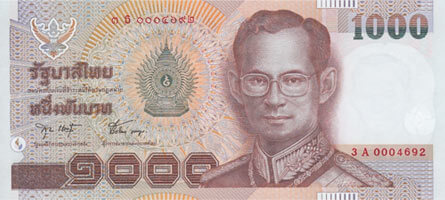

The baht is the currency of Thailand. It is subdivided into 100 satang. The issuance of currency is the responsibility of the Bank of Thailand. According to SWIFT, as of October 2014, the Thai baht ranked as the tenth most frequently used world payment currency.
The Thai Baht is the currency of Thailand. Our currency rankings show that the most popular Thailand Baht exchange rate is the THB to EUR rate. The currency code for Baht is THB, and the currency symbol is ฿. Below, you'll find Thai Baht rates and a currency converter. You can also subscribe to our currency newsletters with daily rates and analysis, read the XE Currency Blog, or take THB rates on the go with our XE Currency Apps and website.
Name: Thai Baht
Symbol: ฿
Minor Unit: 1/100 = Satang
Top THB Conversion: THB/EUR
Top THB Chart: THB/EUR Chart
Inflation: 0.20%
Banknotes: Freq Used: ฿20, ฿50, ฿100, ฿500, ฿1000
Central Bank:
Bank of Thailand
Website: http://www.bot.or.th/english/
Users: Thailand
 USD - Us Dollar
USD - Us Dollar TRY - Turkish Lira
TRY - Turkish Lira IDR - Indonesian Rupiah
IDR - Indonesian Rupiah HKD - Hong Kong Dollar
HKD - Hong Kong Dollar AED - Emirati Dirham
AED - Emirati Dirham THB - Thai Baht
THB - Thai Baht SGD - Singapore Dollar
SGD - Singapore Dollar INR - Indian Rupee
INR - Indian Rupee EUR - Euro
EUR - Euro
Standardized factory minted coins and banknotes were officially issued for the first time in Thailand during the Rattankosin era; with paper money appearing in the form of royal promissory notes in 1853. This was soon followed by banknotes issued by foreign banks. In 1857, Thailand acquired its first minting machine and Thai silver coins began to be minted in the area. Coinage was streamlined in 1897, when the 11 denominations were simplified into two (satang and baht) under a decimalized silver standard system.
Until 1880, the Thai Baht was fixed to the British Pound at a rate of 8 TBH to 1 GBP. This rate changed several times until the Baht was re-pegged to the Japanese Yen at par during World War II. After the war, the currency changed its peg to 20.8 Baht per 1 US Dollar, then to 20 Baht per US Dollar in 1978, and to 25 Baht in 1984.
In 1997, Thailand fell into financial crisis. The Baht lost half of its value prompting the adoption of a floating exchange rate regime. Since the economic collapse, the Thai Baht has stabilized.
Unofficially, the Thai Baht is used in Laos, Cambodia, and Myanmar.
